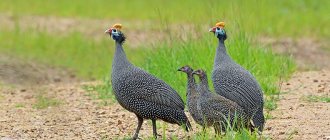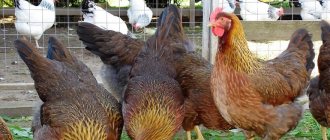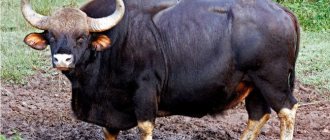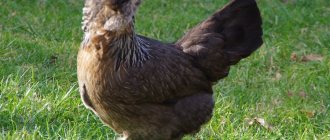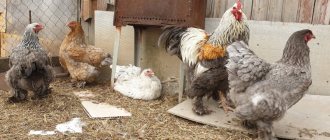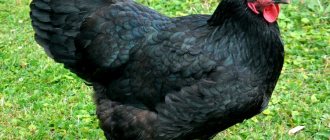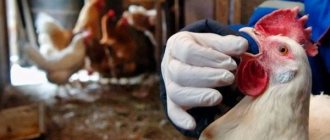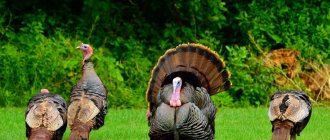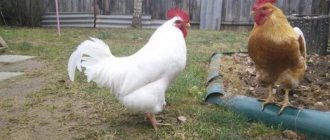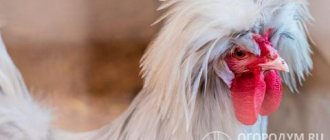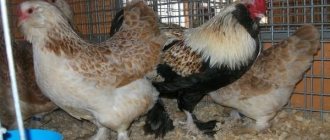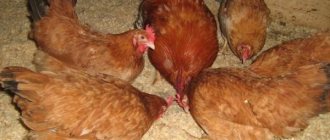Home » Articles about chickens » Breeds of red chickens
Many chickens of national selection have red plumage. Subsequently, breeds and crosses were developed on their basis - breeders achieved improvements in the initial characteristics of the parent generation.
Hungarian giant
Red chickens of this breed were bred in Hungary. They are well adapted to different climatic conditions and have an exterior characteristic of the meat and egg direction. Their body is massive and round in shape. The chest is powerful, the back is wide. The hips are large, the paws are unfeathered. The tail is raised almost vertically. The wings are pressed tightly to the body. The neck is long. The head is small, with a poorly developed red crest and round light lobes. The feather cover is lush, “foxy” (another name for the breed is foxy chick). On the wings and back the color is more saturated than on the rest of the body.
Hungarian giants quickly gain weight - at 3-4 months, excess roosters can be sent to slaughter. By this age they fatten up to 2.5 kg. Adults weigh 4-4.5 kg. Laying hens lay up to 200 eggs weighing 55-60 g throughout the year. Sexual maturity occurs at 4.5-5 months.
Prospects for poultry farming
The growing need of the planet's population for food remains the most powerful incentive to continue breeding work. Modern egg breeding breeds are capable of producing more than 200 eggs in the first year of life. Such successes have been achieved since the twenties of the last century, when, in fact, the targeted breeding of chickens for productive specialization began.
During this time, more than a hundred breeds of chickens for egg, meat, decorative or universal purposes were bred. Today, geneticists are faced with the task of not only maintaining the high egg production of chickens, but also ensuring the quality of the product itself. Pay attention to:
- shell strength;
- egg composition;
- egg weight.
New technologies for keeping poultry are being developed. Work is underway to optimize the composition of feed for laying hens. This will make it possible to obtain eggs with the specified parameters for the qualitative and quantitative content of certain nutrients.
Despite the diversity of breeds, breeders around the world continue to work on developing new lines and crosses. Particular emphasis is placed on crosses. It has long been known that when comparing purebred and cross-bred birds, the latter is preferable.
Crosses are more resilient, hardy, more easily adapt to new conditions, resistant to diseases and have higher productivity. They are used in industrial poultry farming, regardless of the type of product produced - eggs or meat.
A bird that has been close to humans since ancient times and has undergone a huge number of selection changes over many centuries. Chicken, it is impossible to imagine a modern farm without it. And no kitchen in the world can do without eggs and meat.
Wyandotte red
Chickens with red plumage are one of the varieties of Wyandottes. The birds were bred in America. Their feather cover is elegant - red feathers are bordered by a thin black stripe. The predominant color in the tail is black, this is especially noticeable in males. The body is powerful, with a thick neck, strong legs, and short wings. The weight of roosters is 3.4-3.8 kg, hens - 2.5-3 kg. Egg production – 180-200 pcs.
Let's summarize:
In order not to regret the chosen breed and profitability, first study all the egg-bearing breeds presented, choose the best option that will not contradict your aesthetic perception of the outside world. Advice from an experienced farmer will not be superfluous.
Each of these breeds of laying hens is special and you will love and learn to get along with each of them. Your farm will receive a new rainbow of colors thanks to the uniqueness of winged birds.
Good luck in choosing corydalis, dear poultry farmers!
Yerevan red
Yerevan chickens are a universal breed, originating from New Hampshire and Rhode Island. Meat productivity – up to 2.7 kg (females) and up to 3.5 kg (males). Egg production – 160-180 pcs. in year. In the first year, productivity is low, but gradually it increases to the specified levels. The exterior is standard. The body has a triangular shape. The back is short, the legs are fleshy, the chest is wide. The neck is long. The head is medium size. The comb is leaf-shaped. The plumage is red-brown, the tail is black.
Individual record holders
Achieving your own records for raising birds has gained popularity for a very long time. Today, many chicken owners compete with each other, trying to achieve maximum results in order to go down in history. Some just want to share their achievements and give some recommendations to novice poultry farmers.
The largest birds that became famous thanks to their owners and became famous throughout the world are presented:
Little John
This name was given to the Brahma rooster, received from the owner, Jeremy Goldsmith. The giant bird lives in England, Essex. At the age of 12 months, little John was already 66 centimeters tall. It is more likely that by the second year of life the bird will become even taller. The owner does not directly answer what contributed to such a rapid growth of the rooster, but hints that he prepares a special diet for the pet.
Jeremy Goldsmith allows the kids to come in for rooster inspections, and doesn't even mind being fed chips and popcorn.
Big Snow
This nickname was given to the officially registered record rooster in the heavyweight category. The bird belonged to Australian Ronald Alldridge, originally from Queensland. The registration date of the rooster was in 1992, at that time the bird’s weight was 10.36 kilograms, its withers reached a height of 43.2 centimeters, and its chest circumference was 84 centimeters.
The bird breed is quite rare - Whitesulli. Representatives can reach a weight of 8-10 kilograms. The owner of the animal was very proud of his pet, as evidenced by many photos with celebrities, which also depicted Big Snow. In the fall of the same 1992, the bird died of natural causes.
Rooster Coburn
Record holder from the Brahma breed, lives in the UK. His interesting name was given to him in honor of the main character of the American film True Grit. The giant weighs 11 kilograms and is 91 centimeters tall. The owners of Rooster Coburn are a married couple - Mr. and Mrs. Stone. They claim that the bird is a real guard of its chicken coop, because it does not even allow foxes to approach it.
Kuban breed
Red laying hens of the UK Kuban-7 breed are birds with a stocky build, short neck, and medium-length legs. Their feather cover is hard, dense, with a large layer of fluff. The head is small, the crest and earrings are highly developed. The skin on the face is red and there is stubble. Hens are fattened up to 2.5 kg, roosters – up to 3 kg. Egg production – up to 320 pcs. in year.
Historical reference
Since ancient times, on farms and private farmsteads, the most common village chickens were most often a reddish-red or white hue. Autochthonous or folk breeds were highly valued because over many years of breeding in a certain area they developed adaptation mechanisms and insensitivity to climatic conditions. The only drawback of such varieties was low productivity.
Red chickens
But, with the development of breeding science, improved, productive breeds began to appear based on existing local red chickens. Today they are presented in 2 categories:
- breeds;
- crosses.
Important information! Crosses are a genetically unstable variety, and their breeds are the opposite - they are capable of producing offspring with the same breed characteristics when bred "in themselves."
Red whitetail
The breed was bred in England. The body is wide and short. The chest is convex, the legs and thighs are well developed. The head is small, the skin is reddish. The ridge is highly developed and leaf-shaped. The earrings are round. The earlobes are white. The plumage is mostly red, with a gradation of shade, only the tail is light, creamy-white, with a reddish border. The weight of adults is 3.5-4 kg. Egg production – 170-200 eggs, depending on the quality of feeding.
A little history
As you know, people did not immediately domesticate chickens and began to raise them on their farms. Initially, many species were wild, living and breeding in natural conditions.
To date, scientists cannot answer when exactly people figured out how to make useful domestic animals out of chickens. But this only means that domestication occurred quite a long time ago, and that is why no records of the first chicken breeders have survived to this day.
Breeds today are classified by type. The most popular are egg, meat and meat-egg. In addition to these birds, there are also decorative and fighting birds.
Among the varieties known today, only a small part is considered natural - the remaining breeds of white laying hens were obtained through selection at different times. Chickens with light feathers are also, for the most part, the result of the work of breeders.
Red Star
Red egg breed chickens were bred in America. The weight of adult individuals does not exceed 3.5 kg. Over the course of a year, laying hens lay 250-280 pieces. weighing 70 g. Under good conditions, you can count on 300 eggs. Sexual maturity occurs at 4-5 months. Delaware and Rhode Island were used in the selection. The exterior is unremarkable, the crest is small, the tail is slightly raised. The color is light red. There are white inclusions.
Secrets of care
It's no secret that performance indicators depend not only on the genetic potential of the bushes
It is very important how the most egg-laying chicken breeds feed and in what conditions they live. Below we will look at a few secrets that will help you unlock the full productive potential of your herd.
- Provide nutritious meals three times a day. The menu should be balanced and varied. During the period of activity, the need for calcium and proteins increases.
- Use premix additives that stimulate egg laying. But, do not overdo it, so as not to provoke vitamin deficiency.
- Try to organize your family life in such a way that there is no room for frequent stress that disrupts the stable cycle.
- Add fat-containing foods and sources of animal protein to your meals.
- Use flaxseed to improve your performance.
- Observe the light regime - this is the key to success.
- Keep it clean and warm to ensure the hens lay consistently.
Don't miss out on new products - subscribe to site updates to always be the first to read the latest publications!
Wish you all the best!
See modern products for poultry and livestock farmers that improve the health of pets and make our work easier.
Maran black-copper
This breed of black and tan chickens is of French origin. The bird's body is black, the neck and head are red. There are patches of colored feathers on the chest. Roosters have bright plumage on their backs and wings. The birds are large, with dense dense feather cover. The comb is fleshy, large, and can be tilted to one side. The weight of females is 2.5-3 kg, males – 3.5-4 kg. Number of eggs – 150 pcs. in year. The peculiarity of marans is their very dark, chocolate-colored egg shells.
Dominant
Numerous crosses bred in the Czech Republic. Includes several varieties of chickens that differ in color, egg shell color and direction of productivity.
Characteristic:
- Egg production (per year): 280-320 pcs. (60-70 g).
- Color of testicles: brown in different shades, cream, blue, green.
- Laying hen weight: 2 kg.
- When they start laying eggs: 120-150 days.
Farmers more often keep grey-speckled, black, blue and silver dominants on their farms. Dominant hens begin to lay eggs early and the eggs are large. The peculiarity of the cross is its demands on the composition of the feed mixture. With a lack of protein and calcium, egg production decreases.
IMPORTANT: when breeding, the egg production of young animals will be much lower, since this is a typical cross.
New Hampshire
The chickens are large, with red plumage and black tail feathers. The body is oval. The neck is covered with a beautiful feather collar. The tail of roosters is lush, raised 45 degrees in relation to the back. In chickens it is small and slightly raised. The comb is fleshy, leaf-shaped. Females weigh 2.1-3 kg, males - 3.25-3.75 kg. Egg production – 200 pcs.
Determining the egg production of laying hens
Second. A good chicken is selected based on daily productivity monitoring over a period of 7 days. In the morning, laying hens are inspected for the presence of eggs. The bird is fixed at the base of the wing, and lightly pressed on the cloaca to determine whether there is an egg or not. Good layers have it every day. In hens with poor performance, the gap between egg production may be several days.
Third. Appearance can tell a lot about productivity; first of all, the comb with earrings can be inspected. They should be large, soft to the touch and red in color. Chickens with low egg production have small, pale and wrinkled combs.
Fourth. Condition of the cloaca. Laying hens are distinguished by a large, moist, elongated cloaca. A chicken that does not lay eggs has a small cloaca, and it is also dry and compressed.
Oryol scarlet
This ancient Russian breed was bred on the basis of fighting chickens. The birds are hardy, well adapted to frost. The body of roosters is almost vertical, hens are squat, with a horizontal body position. The back of the head and neck are covered with lush plumage, and there are sideburns on the head. The comb is small. Scarlet feathers are one of the color options. The brown-breasted and black-breasted subspecies have been bred. Meat productivity – 2.2-3.1 kg. Number of eggs – 145 pcs. in year.
Features of caring for adult hens and Hisex chicks, their breeding
Despite the unpretentiousness emphasized in reviews by all farmers regarding crosses of the Hisex chicken breed, keeping chickens has some peculiarities. For their successful development and reducing the mortality rate of livestock, it is necessary:
- Ensure the temperature of the room for young animals is 22°C, if necessary, install infrared lamps and heating devices in the chicken coop
- Avoid overheating of young chickens, which occurs at a temperature of 25-28°C, since when it occurs, fatigue and a decrease in motor activity are first observed, after which immobility occurs, and as a result, there is a high probability of death of the young.
Despite good compatibility with other species, in order to prevent damage to common avian diseases and infections, including staphylococcus, pullorosis, brucellosis and salmonellosis, timely vaccination and separate keeping of chickens are recommended.
Conditions of detention
As noted above, the characteristics of the breed practically exclude the cellular content of Highsex. If the breeder nevertheless decides to resort to this method of keeping, it should be noted that there should not be more than 2-3 individuals in the cage. It must have good lighting, a heating system, feeding, watering, collecting eggs and be equipped with the necessary means of maintaining microclimate parameters and protection from predators and rodents.
The floor-based method of keeping hens, which is more common for individual farms, despite the unpretentiousness of laying hens, should include:
- Necessary indicators of personal space, providing for a lower stocking density in relation to conventional breeds of chickens and equipping the chicken coop with a sufficient number of perches and a container with wood ash and sand to prevent the appearance of parasites.
- The optimal temperature should be maintained in the range of 15-20°C; it is undesirable to allow it to drop below 12°C.
- The required length of daylight hours, which should be about 10 hours.
- The chicken coop must be equipped with an air ventilation system, containers for collecting eggs, and a separate area for walking chickens.
Dryness, shaking and changing the litter as it gets dirty, taking recommended preventive measures to prevent the appearance of insect pests and pathogenic microflora.
Diet
For the full development of chickens and obtaining Highsex chickens with a high degree of productivity, experienced farmers advise adhering to the nutritional system and the following recommendations:
- Feeding chicks at the age of several weeks should begin with a mixture of chopped greens and boiled eggs.
- During this period, it is recommended to replace the water in the drinkers with heated milk; the freshness of the milk is a prerequisite, since a spoiled product can cause disease in the chicken’s gastrointestinal tract.
- As the chicks grow older, it is necessary to include in their diet parts of vegetables and fruits cut into large pieces, mixed feed, mash based on water and corn flour.
- Feeding adult laying hens should include systematic additions of balanced mineral and vitamin supplements, legumes, nettles, vegetables, coal and chalk.
When entering the age of active egg-laying, the basis of the feed ration is compounded feed, which, in the opinion and reviews of some breeders, is one of the disadvantages of the breed. Other farmers claim that the costs are more than compensated by the high productivity of the hens.
Video: Hisex Brown - arrangement of a winter chicken coop, its heating and feeding features
Breeding specifics
The difficulty of breeding Hisex chickens is that when crossing with other breeds, traits are not inherited.
In this regard, to update the livestock, it is necessary either to promptly purchase pullets from trusted suppliers, or to use high-quality eggs obtained from poultry farms.
Video: Hisex cross chickens
Orpington red
The red subspecies of the breed was bred in Germany on the basis of yellow Orpingtons, red Rhode Islands and Sussexes. The birds are large, with a straight back, thick neck, strong legs, and scanty red plumage that fits tightly to the body. They are hardy and can withstand heat and cold well. The live weight of chickens is 4.5-5.5 kg, of roosters - 5-7 kg. Number of eggs per year – 160-180 pcs. Hatchability: 93%.
Poultry keeping
Redbros are quite unpretentious in their content. But there are some nuances that should be taken into account when arranging a poultry house for chickens of this breed.
Chicken coop and equipment
An unheated but insulated poultry house is suitable for keeping redbros, which should also be quite spacious. The recommended height of the chicken coop is up to 1.8 m. Containers with sand or ash are installed in the poultry house for cleaning feathers.
It is recommended to keep no more than 20 chickens per 10 m2.
If you plan to grow redbros for meat, it is recommended to keep them in cages.
Perches
Redbro perches are installed in a place protected from drafts. It is recommended to place them at a height of 40-50 cm. The optimal length of the crossbar for one chicken is up to 30 cm, the distance between the bars is no more than 40 cm, their thickness is about 7 cm.
Nests
The recommended height of nests for laying hens of the Redbro breed is 30 cm, depth is 35 cm. It is recommended to place them in a remote and fairly shaded part of the house. There should be one nest for every 4 laying hens.
Feeders
It is recommended to place deep and voluminous chicken feeders along the walls of the chicken coop. They should be made of plastic or metal, since wooden containers will quickly get wet from wet mash. Food containers should be scalded with boiling water every day, disposing of uneaten remains.
Drinking bowls
Plastic or enamel drinkers should also be installed in the poultry house. Metal containers are not suitable because they quickly rust when in contact with water. Ceramic drinkers are not safe for redbirds because they can break off and ingest particles, which can be fatal.
Litter
The litter must remain dry. It should be changed every year with the onset of spring and autumn. It is recommended to use wood shavings, peat or straw as flooring material. The optimal thickness of the litter is from 10 to 15 cm.
Temperature and humidity
The optimal temperature for keeping a redbro broiler in the warm season is no more than +27°C. In winter, chickens feel good even when the temperature drops below +7°C. Additional heating is only necessary if the temperature in the poultry house drops below +5°C.
It is important to avoid drafts. To maintain the humidity level within 25-30%, it is recommended to install a window inside the house. It should be covered with a net to prevent insects from entering the coop.
Lighting
The optimal length of daylight for redbro is 13 hours. In order for chickens to continue laying eggs in winter, daylight hours will need to be artificially extended.
Room hygiene conditions
Cleaning the chicken coop should be done once a month, and disinfection of the floor, walls and equipment – 2 times a year. For treatment, it is recommended to use a solution of creolin (5%) or soda (2%). After disinfection, the poultry house is also whitewashed with lime.
Sulfur bombs are effective in the fight against parasites and fungi. But they can be used to treat the poultry house only if there are no chickens.
Additionally, disinfection treatment must be carried out before introducing new redbred stock into the poultry house.
Rhode Island red
Rhode Island Red chickens were bred in the USA based on five breeds. The bright color of the feathers is characteristic of one of the subspecies. The bird's body is rectangular, set horizontally. The back is wide, long, the chest is convex, the wings and tail are small. Legs are strong. The main color of the plumage is red, the color on the legs is lighter. The flight and tail feathers are painted black. The weight of roosters is 3.5-3.8 kg, chickens are 2.7-3 kg. Laying hens lay 160-170 eggs per year. Vitality is high. Sexual maturity is reached at 7 months.
Hamburg
An ancient breed that originates in Holland, but it was recognized in the German city of Hamburg. Local chickens were used to obtain it. They are often kept as ornamental, but at the same time they show good egg production.
Peculiarities:
- Egg production (per year): 175-250 pcs. (45-55 g).
- Testicle color: white.
- Laying hen weight: 1.8 kg.
- When they start laying eggs: 120-150 days.
Small chickens with an attractive appearance. They need a large enclosure with a closed top, as they fly well. The colors are divided into two groups: speckled (golden, flesh to tan, silver and lemon with black speckles) and edged (golden and silver).
INTERESTING! There are also black and white chickens. The comb is pink, the lobes are white.
Shumavskaya
The Czech breed of red chickens is called Šumava or Šumava. Hens are fattened up to 3-3.1 kg, roosters – up to 3.5 kg. Puberty occurs at 5-6 months. Egg productivity – 180-200 pcs. in year.
The physique is proportional. The body of males is elongated, with a protruding chest. Females are more stocky. The thighs and legs are well developed and fleshy. The neck is long. The head is small, the crest is fleshy, low, and nut-shaped. The beak and paws have a grayish tint. The tail is high. The color of roosters is red-brown, females are lighter.
Feeding adults
In the summer, free-fed chickens can easily provide themselves with a full diet on their own. The rest, who only go out for walks in the walking yard, are fed 3 times a day. Birds have no special food preferences. However, the diet must be nutritious and contain vital substances - minerals, vitamins, proteins.
The bird gets calcium from ground shells, chalk, and shell rock. Fine gravel must always be available. It has a good effect on the digestive system.
Necessary vitamins are found in green grass. In the summer it is in abundance, so it should be present in the diet every day. In winter, they provide fresh root vegetables - carrots, beets, zucchini, as well as apples, harvested hay, and yeast. Wet mash with the addition of meat or fish meal is given all year round. In winter, such food is given warm so that the bird can warm up additionally.
Tetra
The breed is fast growing - already at 4.5 months the weight exceeds 2 kg, adult individuals fatten up to 2.6-3 kg. Birds have a long body. Roosters look fit, chickens have a round belly. The head is small, with an erect leaf-like crest. The color of the roosters is red, the hens are lighter. The first clutch occurs at 4-6 months. Over the course of a year, birds lay up to 300 eggs with brown shells. Average weight 1 pc. – 60 g.
Does the egg production of laying hens depend on feed?
Undoubtedly! Summer feeding is standard.
- If you add grass and greens to the grain and mixed feed, then the black whales will not need any food additives when kept indoors. But it is advisable to place a vessel with gravel, sand, and chalk.
- If the birds have free range, then there are even fewer difficulties with feed, and the chickens are healthier and eat less grain and feed.
- Winter maintenance of egg-laying chickens requires a special approach, we described this in detail in the article “What to feed chickens in winter and how to keep them so that they lay eggs.” In winter, it is better to give Premixes and Ryaba, 1 tablespoon per feed per 10 heads. The probiotic Bioximin has good reviews from breeders.
How to choose on the market: what parameters should you rely on when choosing?
You can buy day-old chicks and wait until they grow up to realize that there are more cockerels in the flock than hens. Or you can buy young animals, basing your selection on characteristic exterior features.
Signs of good egg production can be:
- Comb and its color;
- The volume of the abdominal cavity and its softness;
- The distance between the pubic bones (at least 3 fingers of an adult’s hand);
- If the bird is closer to the egg type, then the brow cranial arches are poorly developed and the front part of the head is characterized by weak hair.
When purchasing egg-bred chickens on the market, you should take a close look at the pigmentation of the beak. The more productive the laying hen, the faster it disappears.
conclusions
In homestead livestock farming, chickens of egg breeds are often raised. Among the most productive are Leghorn, Russian White, Highsex, Loman Brown, Kuchinskaya Jubilee. Every 2-3 years, due to a decrease in productivity, chickens are culled, and the poultry farmer buys replacement young stock. To select egg-laying chickens for further use, you need to pay attention (especially to beginners) to the following exterior signs of high productivity:
- The correct distance between the pubic bones should be at least 3 fingers of an adult’s hand.
- Volumetric and soft belly.
- Brightly colored and elastic comb and earrings.
- Yellow pigmentation of legs, iris, beak. In the fall, it is paler in highly productive chickens.
- Shedding. Good layers molt in mid-autumn.
- Plumage. In a healthy and highly productive bird, it is shiny and tightly adjacent to each other.
You can read about why chickens go bald here.
Diseases
No diseases inherent in the California Gray chicken breed have been identified. By nature they are immune to viral and infectious diseases. If the proper conditions are observed, the birds do not get sick.
- Parasites
- Infectious
- Other
Chicken mite
How to treat a chicken coop and how to treat a bird. Description of drugs and methods of control
Read
Coccidiosis
Thirst, loss of appetite, swelling, bloody droppings, anemia, weakness, poor coordination
Read
Ascariasis
Loss of appetite, liquid droppings, pale mucous membranes of the comb, limbs, ruffled plumage, lethargy, vomiting
Read
Amidostomiasis
Symptoms of the acute form: apathy, general weakness, decreased or lack of appetite, breathing problems, unsteady gait, retarded growth and development
Read
Prostagonymosis
Decreased mobility, loss of appetite, unsteady gait, bloating, fever, impaired egg laying, exhaustion
Read
Knemidocoptic mange (“lime foot”)
Acute symptoms: light gray bumps appear on the legs, the bird limps and stands on one leg, the cloaca and joints become inflamed, the beak is deformed
Read
Heteracidosis
Symptoms: indigestion, diarrhea, loss of appetite, lethargy, decreased egg production, retarded growth and development
Read
Trichomoniasis
Symptoms of the acute form: fever, depression and loss of appetite, diarrhea with gas bubbles and a putrid odor, enlarged goiter, difficulty breathing and swallowing
Read
Pullorosis (typhoid fever, salmonellosis)
Weakness, lack of coordination, drooping eyelids, difficulty breathing, lack of appetite, indigestion
Read
Colibacillosis
Lack of appetite, thirst, sudden increase in temperature, pale scallops, diarrhea
Read
Pasteurellosis
Fever, foamy mucus, change in stool color, refusal to feed, thirst, lethargy, wheezing, heavy breathing
Read
Marek's disease
Paralysis of the limbs, difficulty breathing, severe exhaustion and loss of strength, refusal of food and water, pallor of the scallop
Read
Gumboro disease
Diarrhea, loss of appetite, trembling legs and head, sudden death
Read
Laryngotracheitis
Weakness, swelling of the neck, difficulty breathing, cough, wheezing, blood clots in the mucus released when coughing, lack of appetite, indigestion
Read
Bird flu
Refusal to eat, anorexia, diarrhea, purulent discharge, hoarse breathing, greenish-brown droppings, seizures, darkening of the ridge
Read
Newcastle disease
Decreased appetite, fever, respiratory distress, immobility, conjunctivitis, bloody diarrhea
Read
Apteriosis
Complete or partial absence of plumage, loss of tail feathers, broken embryonic fuzz in young animals, delayed growth of plumage, pecking
Read
Pterophagy
Plucking and eating feathers. What is the reason, why does it require urgent intervention and how to prevent the disease?
Read
Yolk peritonitis
Symptoms of the acute form: loss of appetite, gray-green color of feces, sudden drop in egg production, calcareous deposits on the shell, bluish tint and baldness of the abdominal skin
Read
Cloacite
Symptoms: depressed state, decreased appetite, weight loss, increased need for water, loss of plumage, inflammation and bulging of the cloaca, the presence of ulcers on the mucous membrane, decreased egg production
Read
